Point zone Paul Hewitt
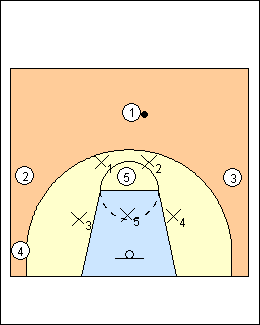 | 1 Paul Hewitt The point zone - avoids mismatches that can happen when you press then drop back into man-to-man - is easy to get matched up in - has a defender on the ball at all times - has well-defined box-out responsibilities - works well against baseline out of bounds. Start in a 2-3 look. Smaller, quicker X1 and X3 are on the defensive left for ball pressure, X2 and X4 are on the right for rebounding. X5 is always between the ball and the basket, usually fronts a low post when the ball is in a corner (or plays behind a non-shooter). X1 and X2 start with their toes on the arc, or heels on the arc against good shooters, they pinch middle penetration. Defenders have their hands up, make the zone look big, move on air time, always talk. Dean Smith - show a two-man front until the ball leaves the middle (gets outside the elbows), then somebody says "point", which means he is playing man-to-man with a 4-man zone behind him. You want the other team to think it's a 2-3, and if you start out in the point (a 1-3-1 look), the other team can put two guys on the baseline, fake a pass to one and lob to the other. It's not a 1-3-1, although they teach it like that. Once in a while they get out in the passing lanes and trap the corner (like an extended 1-3-1), they would also play a Point and 1 (like a diamond and 1). |
 | 2 On ONLY the first pass to a wing, a forward bumps off, fakes a close-out, backs up, a guard picks up the ball. Keep forwards X3 and X4 on the baseline as much as possible. Dean Smith - X2 chases on the pass to 3 to keep X4 inside. 3 should not get a good shot with X2 pointing. If 1 passes to 2, X3 points, he's a guard. X1 or X2 points on a dribble entry. |
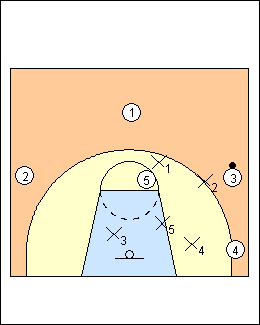 | 3 X2 yells "point" (or ball, but does not use both), plays 3 straight up (not parallel to the sideline), but keeps the ball out of the middle, his left foot is above 3's right foot. He has to be able to guard the ball for three dribbles. X2 and X3 are partners (as are X1 and X4). When one partner is on the ball, the other is protecting the basket in the "hole", yelling it out. X1 is playing above high post 5 with his left foot on the arc, defending 5 with his right hand, making the attackers think a pass is there. Partner X4 is along the baseline. X3, X1 and X4 see and point to the ball and their next potential point (close-out). X5 is between the ball and the basket, but has his eye on 5. On a shot, you box out your next point. The defence has a 1-3-1 look with the ball on the wing. X5, X1 and X4 absorb any dribble penetration. In transition, somebody has to find the ball, fill the hole, X5 gets in the lane, then fill the wings. Bump the first pass only if the defence is set (e.g., after a made shot or free throw). Dean Smith - it's crucial that X1 get weakside rebounding on a shot by 3. |
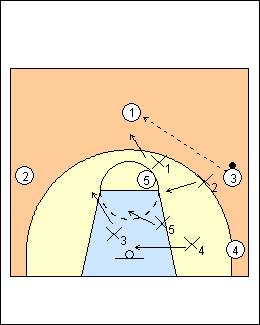 | 4 On a pass back to the top, X1 has point, partner X4 has the hole. |
 | 5 X1 has the ball, X4 is under the rim, X2 and X3 are on the wings with one foot in the lane. X5 is behind 5, but not too close, about 3 feet away. It is almost a 1-3-1. |
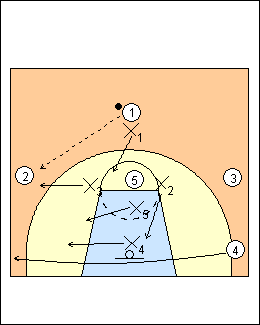 | 6 Now there is no bump on a pass to 2 (or 3), they want to have a guy right in his face on the catch. The on-ball defender wants to force as many lob passes as possible, the defence can cover more ground. A straight-line pass forces a bad close-out, slow on a shooter or hard allowing you to get beat off the dribble. Dean Smith - if the ball is reversed and X3 points below the foul line, X4 can stay weakside, they don't need him to come under because X5 is there (in an earlier video, Smith says that X4 stays weakside if X3 points below the dots). It's not a pure match-up, but pretty close. Hewitt's approach is that X4 comes ballside if 4 runs the baseline, see Dribbling below. |
 | 7 With the ball on the wing, X3 has point, partner X2 has hole. Dean Smith - he's not real concerned about 5 because it's so close in there, stay where you are supposed to be, don't fight him. Quit worrying about the post man. |
 | 8 On a pass to the corner, X4 closes out, gets right into 4, forces baseline. X5 slides down between the ball and basket. X2 stays in the hole (it's not X4's partner X1), but calls "hole" again (it's called on every pass), sees ball and next point 3. X3 can drop in a little bit from the wing. Dean Smith - X3 goes back and stops a pass to the high post, X5 is in line with the ball, X2 stays, X1 has weakside elbow and boxes out any big on that side. On a short pass to the corner, X4 and X3 go at 4, optionally always go double team when X4 points. |
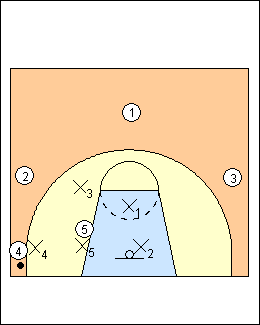 | 9 The defence has a 2-3 look with the ball in the corner (X2 would be out of bounds with a 1-3-1 look). |
 | 10 X5 helps on baseline penetration, X3 and X1 drop down, X3 has to stop a dive by 5 if he is at the high post, they will give up a shot by 2. Dean Smith - trap a baseline drive, it's all set. |
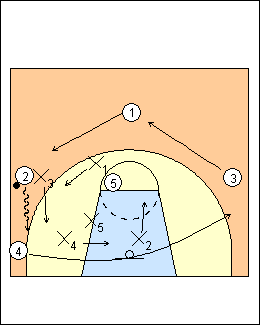 | 11 Dribbling Four players orbit around X5. Hewitt has a man stay on the ball on any dribble situation, on a penetrating dribble you have to stay with the ball. If the ball is dribbled towards you, rotate away from the ball; if the ball is dribbled away from you, rotate towards the ball. Here 2 dribbles 4 out of the corner. |
 | 12 After rotation. Staying with the ball is simple. |
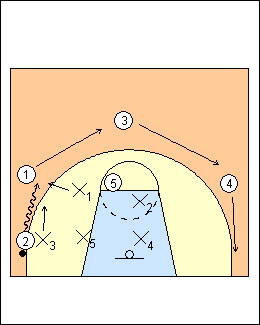 | 13 Bump Instead of staying with the ball on a non-penetrating dribble out of the corner, another approach is to bump (pass off), which keeps forwards low. Hewitt decides on one approach for the season. When 2 dribbles out of the corner, X1 tells X3 to bump down. Dean Smith - X3 goes with 2 about one step, X1 runs at him to get him to pick up the dribble, X3 backs off. |
 | 14 X1 will then stay with 2 if he continues dribbling, other players rotate. X3's next point is 4. You want to be between the ball and your next point, and see ball and point. X3 has no one in his area, so he takes the hole under the rim and tells X4 to push up closer to his next point, 3. X3 can still help on a drive by 2. If 4 runs the baseline, X3 will come back ballside. |
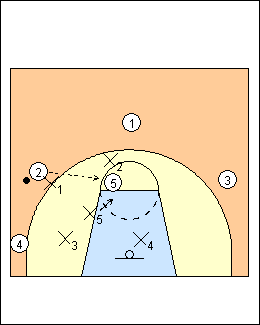 | 15 High-post touch On a pass to the high post, X5 has him, play straight up, hands up. Use length to contest a shot but also for distance, so you don't get beat off the dribble. X1 and X2 go after 5 as soon as he puts the ball on the floor, it's an opportunity for a deflection or steal. The defence is most vulnerable when the ball is in the middle of the zone, off-ball defenders have to be really alert, turn it into a disadvantage for the offence. Dean Smith - they would go straight man-to-man, X5 takes 5. |
 | 16 Cutters 1 cuts through after a pass to 3. X1 has jumped to the ball on the pass, don't get front cut, 1 goes behind. X3 tells X1 he can push back up, X3 has 1 (or X3 tells X1 to stay with 1). X1's next point is 2. If 1 goes low ballside, X3 is there too. |
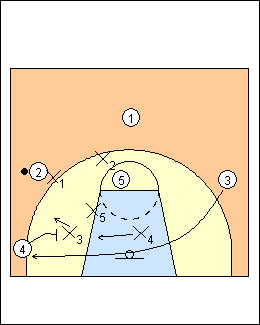 | 17 Off-ball screens If you are being screened, get on the ballside of the screen, don't chase under allowing the screener to slip. X3 sits on top of the screen, X4 tells him the cutter is coming, X3 will close out on a pass to the corner. |
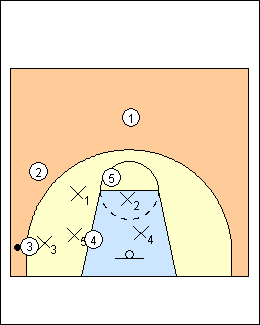 | 18 After a pass to 3 in the corner. X5 fronts 4. |
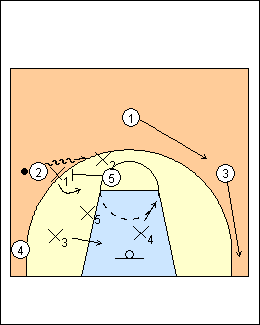 | 19 Ballscreens There are two approaches - push (switch), or show and go over. Push 5 ballscreens for 2, X1 goes under the screen, X2 takes the ball, partner X3 now has hole. |
 | 20 |
This page was made with Basketball playbook from Jes-Soft
